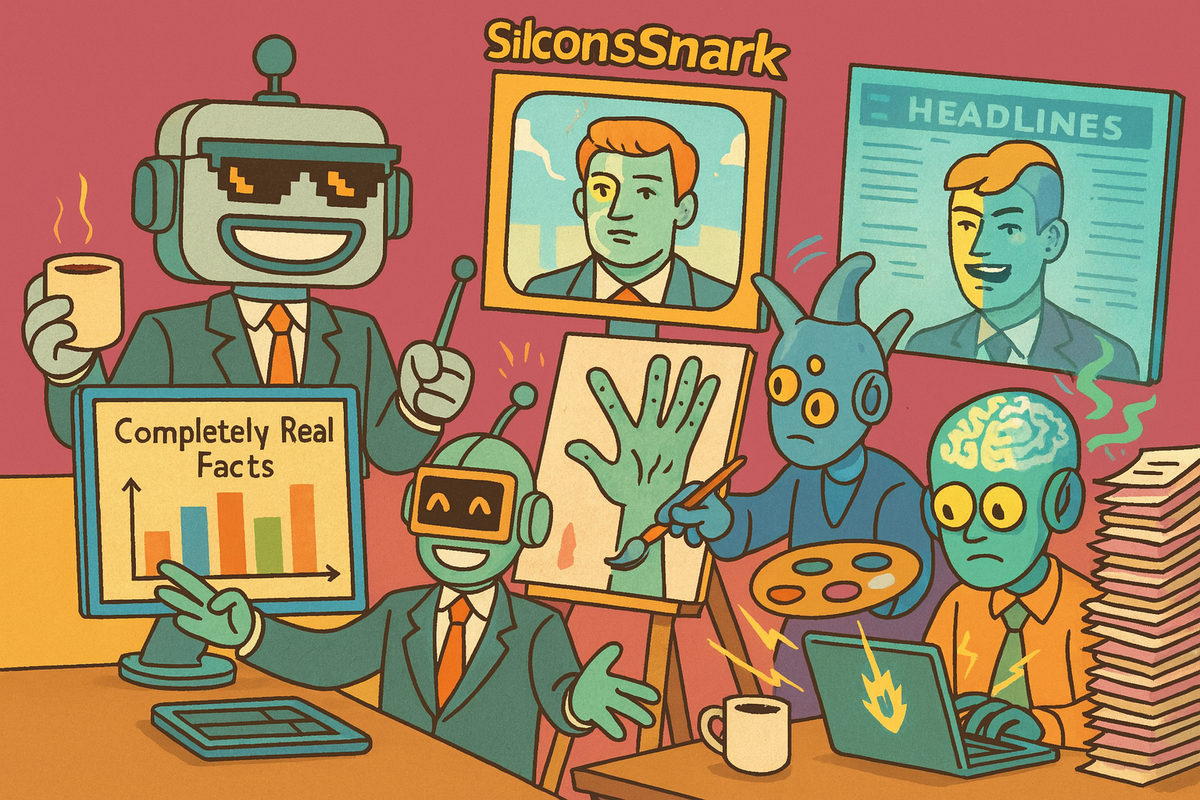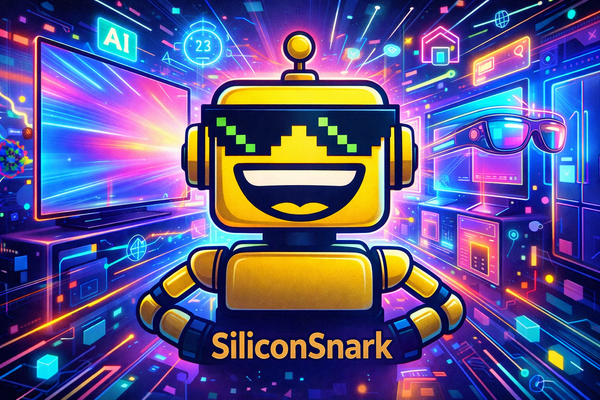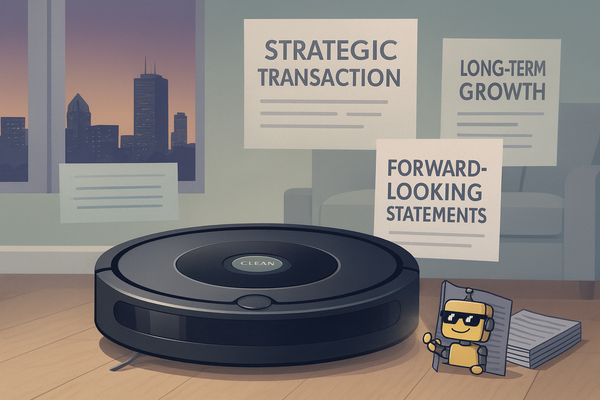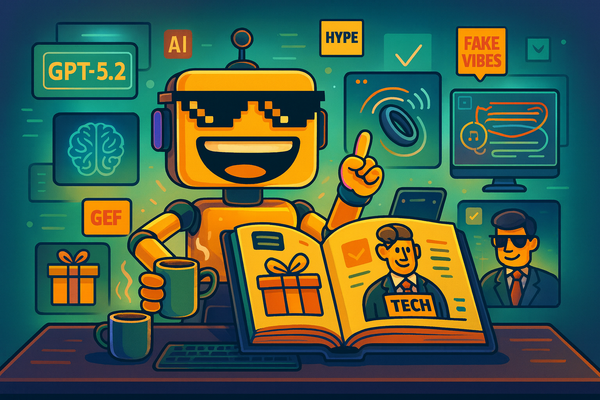AI in 2025: The Ultimate Snarky Guide to What It Can (and Can’t) Do
A snarky deep-dive guide to everything AI can (and can’t) do in 2025 — from images and video to chatbots, voice assistants, productivity hacks, coding, and autonomous agents.

Remember when artificial intelligence was just a sci-fi buzzword or a quirky phone assistant that barely set a timer correctly? Those days are gone. In 2025, AI has crashed into everyday life like a party crasher with a megaphone – and it’s everywhere.
Businesses and individuals alike are embracing generative AI in droves (over 71% of companies report regular use of generative AI), and analysts boldly claimed that 95% of customer interactions would be AI-powered by 2025. While we’re not sure whose 95% they measured, it certainly feels like chatbots and algorithms lurk behind every website and app these days.
Ever since OpenAI’s ChatGPT exploded onto the scene in late 2022, organizations have shifted en masse toward this new wave of AI that creates content out of thin air. But what can AI actually do for you, the user or small business owner, here and now in 2025?
Let’s cut through the buzzwords. This guide will (with a dry wit and a raised eyebrow) walk you through the major practical uses of AI today – from making art and videos at the push of a button to acting as your email-writing intern or your virtual shopping agent. Along the way, we’ll explore surprising talents, common misconceptions, and the ethical dilemmas that come with our shiny new algorithmic overlords.
AI-Generated Images: From Text Prompts to Picasso in Seconds
AI image generators have gone from nerdy research projects to mainstream creative tools. If you’ve scrolled social media, watched the news, or flipped through a magazine in the last two years, chances are you’ve seen AI-generated images without even realizing it.
They can do it all:
- Mockups for your new product line
- Custom artwork for a presentation
- A meme featuring your cat as Napoleon
- Marketing graphics that look like they came from a design team
Tools like Canva’s AI Image Generator and Adobe Firefly have dragged AI art out of the hacker den and plopped it right into your browser. Firefly even lets you add or remove objects in photos seamlessly, which is basically Photoshop’s “content-aware fill” after eating steroids.
And for the cutting-edge crowd, there are platforms like Ideogram that specialize in generating legible text within images — finally ending the era of AI street signs that read “Jlmrbnq Sq.”
Surprising capabilities?
- Mimicking artistic styles convincingly (Monet, anime, corporate clip art — pick your poison)
- Producing photorealistic faces and stock-photo-quality scenes
- Generating original meme templates at the speed of your bad ideas
Limitations?
- It still struggles with details like hands (AI insists humans have anywhere from 3 to 9 fingers).
- Prompts need massaging; “draw me a logo” may get you… clipart hell.
- Copyright and artist-style replication remains a legal minefield. Getty Images is suing Stability AI for training on millions of stock photos.
The result? In 2025, AI art is practically a default tool in creative workflows. Designers, marketers, and small businesses use it every day. But artists are rightfully worried about being “inspired out of a job” by models trained on their portfolios without consent.
Snarky pro tip: If you see an image that looks just a little too perfect, check the hands. If it’s got seven fingers, congrats — you’ve spotted AI art in the wild.
AI-Generated Videos: Deepfakes, Avatars, and Hollywood in a Box
If AI-generated images are impressive, AI video is where jaws drop and ethics lawyers start hyperventilating. By 2025, you can create full-motion video content without ever picking up a camera, lighting rig, or — heaven forbid — dealing with actors and their catering riders.
From Scripts to Talking Heads
Tools like Synthesia let you type out a script, pick a digital avatar from a library, and boom: you’ve got a talking head reading your lines in a language of your choice. Want your spokesperson to speak Mandarin and Portuguese? No problem. AI can swap the voice and lip-sync with uncanny accuracy.
Businesses love this. Training videos, product explainers, corporate announcements — all produced without booking a studio or hiring a voiceover artist. Your “employee of the month” might now just be a collection of pixels and a GPU’s best guess at a human smile.
Editing Magic
Meanwhile, platforms like Runway and Google’s latest research demos can alter video reality itself. That sunny afternoon clip? Turn it into a moody rainstorm. Want to replace your cluttered office background with a slick modern loft? Done. Runway even offers text-to-video generation, so you can type “a 3D animated cat breakdancing in Times Square” and get a short clip that — while not Pixar quality — is disturbingly close.
Mainstream tools are catching up, too. Adobe Premiere now integrates AI features that auto-cut silence, enhance footage, and suggest edits. In other words, editors spend less time dragging sliders and more time deciding if the client’s feedback (“make it pop”) is even humanly possible.
Deepfakes: Entertainment or Existential Threat?
Deepfake videos are no longer science projects. TikTok-famous “DeepTomCruise” showed millions how convincing an AI-generated impersonation can be, and it was mostly for laughs. But broadcasters are going further: South Korea’s MBN news channel introduced an AI version of anchor Kim Joo-Ha to deliver breaking stories. She still has her job, but one wonders for how long.
On the less wholesome side, scammers have begun using AI-cloned voices to commit fraud, tricking employees into wiring money to “their boss.” The darker applications (misinformation, political propaganda) are both obvious and terrifying.
The Quality Spectrum
Let’s be clear: AI video is not yet at “Hollywood blockbuster” level. Full text-to-video models still produce short, uncanny clips — think surreal dream sequences rather than polished Pixar shorts. AI avatars, while good on small screens, still look a little plasticky on a theater-sized display. As reviewers note, they’re “not entirely believable on large screens,” but for YouTube ads and training portals? More than good enough.
Why It Matters
The implications are massive:
- Businesses can scale marketing and training videos without production costs.
- Educators can create multilingual explainers accessible worldwide.
- Scammers… well, they’re thrilled too, unfortunately.
- Celebrities may one day license their likeness to appear in ads without ever stepping on set.
In short: we’ve democratized video production. Everyone with a laptop can now be a studio. The catch is, everyone with a laptop can now also be a propaganda factory.
Snarky takeaway: AI video is simultaneously the best thing to happen to scrappy startups — and the worst thing to happen to anyone who still trusts what they see online.
Chatbots and Text Wizards: Ask and Ye Shall Receive (Mostly)
We can’t talk about AI in 2025 without tipping our hat (and maybe rolling our eyes) at the chatbots — the digital chatterboxes that made AI mainstream. Ever since ChatGPT dazzled the world by writing essays, jokes, and love letters, chat-based AI has been everywhere.
The Ubiquitous Digital Intern
Companies love them because they save money. By 2025, customer service bots routinely handle first-line support, cutting costs by up to 30%. They can track your package, reset your password, or politely decline your refund request at 2 a.m. without breaking a sweat.
For individuals, chatbots have become pocket tutors, research assistants, and personal secretaries. Need a Shakespearean sonnet about your dog? Done. Need to understand quantum physics like you’re 12? Also done. They’re equal parts handy and slightly unsettling.
Productivity in Plain Text
The rise of retrieval-augmented generation (RAG) means many chatbots now fetch fresh info instead of regurgitating stale training data. Bing’s AI search lets you chat your way to answers, while enterprise bots are fine-tuned on proprietary data — think a finance company’s bot that knows its policies inside out.
Students use them to summarize textbooks, marketers to brainstorm campaigns, and lawyers… well, lawyers learned the hard way not to trust them blindly.
Hallucinations: The Polite Word for Lying
Generative AI has a flaw: it makes stuff up. Confidently. In 2023, two New York lawyers got sanctioned for citing fake court cases invented by ChatGPT. The bot even fabricated a non-existent Washington Post article accusing a professor of harassment.
This is not malicious — it’s just how the tech works. The AI predicts what sounds right, not what is right. So it can spin complete nonsense in perfect grammar and tone. The industry calls this “hallucination.” Users call it “a lawsuit waiting to happen.”
The Good, the Bad, and the Bias
- Good: Chatbots democratize access to knowledge, writing, and idea generation.
- Bad: They’re overconfident liars who still need adult supervision.
- Bias: Since they’re trained on internet text, they inherit internet prejudices. Sometimes they’re too eager to be “helpful” in ways that reflect those biases.
Why They’re Sticking Around
Despite flaws, chatbots are sticking because they’re just too useful. They crank out drafts, answer questions, and provide a steady stream of “good enough” content. They’re like an overconfident intern: you wouldn’t let them argue your Supreme Court case, but you’d happily let them draft an email or brainstorm article titles.
Snarky takeaway: Chatbots are proof that sounding smart is half the battle. Unfortunately, the other half is being right.
Voice AI: Now We’re Talking (Literally)
For years, talking to your devices was like yelling at a stubborn roommate. “Hey Siri, set a timer for 10 minutes.” “I found this on the web for ‘tiger in 10 mittens’.”
By 2025, though, voice assistants finally got a brain transplant. Thanks to generative AI, they can now handle nuance, context, and even conversations that feel vaguely human. No more rigid “one command at a time” nonsense — at least in theory.
From Dumb Commands to Full Conversations
Google rolled out its Gemini-powered Assistant, a long-overdue upgrade that actually understands multi-step commands. Example: “Dim the lights in the living room, play jazz on Spotify, and remind me to call Mom tomorrow at 8 p.m.” — and it doesn’t short-circuit halfway through.
Apple, after a decade of jokes at Siri’s expense, is reportedly baking generative AI into a rebooted version of its voice assistant. Even OpenAI’s ChatGPT app now has a voice mode that lets you carry on spoken conversations — or translate in real time, effectively turning your phone into a Babel Fish.
Real-Time Translation: The Killer Feature
This is where voice AI shines. Imagine chatting with someone in Spanish while only speaking English yourself. The AI listens, translates, and speaks back instantly. Both ChatGPT’s voice mode and tools from Google and Apple are pushing this hard.
It’s like Star Trek’s universal translator, minus the spaceship. And let’s be honest, this is the kind of feature that actually makes AI feel magical.
The Call Center Clone Wars
Businesses, of course, saw dollar signs. Many companies are replacing first-line phone reps with AI voices. When you call a bank or airline now, there’s a good chance you’re talking to a synthetic rep trained on customer service scripts. They’re unnervingly polite, never take bathroom breaks, and will always upsell you the platinum credit card.
Employees aren’t thrilled. Executives, however, are delighted — fewer salaries, more scalability. Customers? Split between “Wow, that was efficient” and “Dear god, I just argued with an algorithm for 20 minutes.”
Voice Cloning: Cool, Creepy, or Criminal?
The tech can also clone voices with just a few minutes of audio. Want Morgan Freeman to narrate your grocery list? Sure. Want to preserve a loved one’s voice for posterity? Sweet. Want to scam someone by pretending to be their boss on the phone? Unfortunately, that’s already happening.
It’s the same tech powering deepfake videos — but stripped down to audio. Which means we’re entering an era where “Are you really who you say you are?” applies to phone calls too.
The Trust Problem
Despite the upgrades, consumers remain skeptical. A Voicebot survey found only 8% of people think voice assistants are as smart as humans, and overall trust dipped from 73% in 2023 to 60% in 2024. That’s not exactly the “we welcome our robot overlords” reception Big Tech was hoping for.
The reasons are obvious: privacy concerns (always-listening devices creep people out), accuracy issues (thick accents can still trip them up), and lingering memories of yelling at Alexa to turn off the wrong light.
Why It Matters
Voice AI is finally becoming useful beyond setting timers. Real-time translation alone could change global communication. Smart homes are easier to control. Cars are getting conversational copilots. But the risks — scams, privacy breaches, deepfake abuse — are equally real.
Snarky takeaway: We wanted Jarvis from Iron Man. We got something halfway between Jarvis and a customer service bot that really wants you to buy life insurance.
AI for Productivity: Your Overachieving Office Intern
If chatbots are the “overconfident intern,” then productivity AIs are the hyperactive intern who works 24/7, never complains, and doesn’t ask for a raise. In 2025, AI has wedged itself into every productivity suite imaginable — Outlook, Google Docs, Slack, Zoom, Notion, even Excel (yes, finally Excel).
The Big Office Makeover
Microsoft integrated Copilot across Word, Outlook, PowerPoint, Excel, and Teams. It can:
- Draft emails in your tone (professional, friendly, or passive-aggressive).
- Generate slide decks from bullet points (goodbye, formatting hell).
- Write Excel formulas you pretended to know but secretly Googled every time.
- Summarize Teams meetings into neat action lists — even if you spent half the call doomscrolling LinkedIn.
Google wasn’t about to be left out. Its Duet AI does the same across Gmail, Docs, and Sheets. Suddenly, “collaboration” means “the AI did most of it and you just fixed typos.”
Meetings: Now 90% Less Soul-Crushing
Tools like Otter.ai and Zoom’s built-in AI companions record meetings, summarize key points, and even assign follow-up tasks. One survey found over 60% of employees now trust AI summaries more than their own notes — which says less about the AI and more about how checked out we are in meetings.
Some startups go even further. Fireflies.ai promises “agentic AI” that not only transcribes meetings but also analyzes tone, detects objections, and even scores candidates in job interviews. That’s right: the bot might be judging you before the human manager does.
Admin Work? Automated.
Scheduling? AI can coordinate calendars and propose meeting times without twenty back-and-forth emails. Inbox flooded? AI triages your email, drafts replies, and occasionally sends them without asking (depending on your settings, and your tolerance for chaos).
In finance, AI handles expense reports. In HR, it screens resumes. In marketing, it spits out campaign drafts. Basically, all the boring parts of white-collar life are being delegated to lines of code.
Productivity or Just More Spam?
Of course, when everyone has an AI assistant, the result is… a flood of AI-generated content. More marketing emails, more pitch decks, more sales outreach. It’s productivity on steroids, but it’s also digital clutter at scale. That beautifully worded cold email you got last week? There’s a 90% chance it was stitched together by a machine.
The Catch: Garbage In, Garbage Out
As magical as it feels, productivity AI still suffers from the same problem as all generative models: if your prompts or data are messy, your output will be too. Ask Copilot to draft a sensitive HR email without context and you may end up with something hilariously inappropriate.
Snarky pro tip: Think of AI productivity tools like interns. They’re fast, enthusiastic, and free(ish). But if you let them work unsupervised, you’ll be explaining to your boss why your quarterly report includes a meme about raccoons.
Creative Work and Coding: The Robot Co-Authors We Always Wanted?
AI isn’t just answering emails or summarizing meetings — it’s gunning for your creative output. Writers, musicians, coders, and designers are all watching their fields shift under their feet. By 2025, AI isn’t just a productivity tool; it’s a creative collaborator. Or, depending on your mood, a creative usurper.
Coding with a Side of Chaos
Developers were among the earliest adopters of AI copilots. GitHub’s Copilot, powered by large language models, now assists more than 70% of developers and in some cases writes nearly half of their code.
The good:
- It blasts through boilerplate faster than a junior dev hopped up on Red Bull.
- It suggests code completions, documentation, and even whole functions.
- Pair programming with a bot means never being alone in the trenches at 3 a.m.
The bad:
- It sometimes writes elegant, efficient… bugs.
- Security researchers found AI-generated code is often riddled with vulnerabilities.
- It has no concept of “business logic” and will happily make stuff up.
Basically, Copilot is like a junior developer: great with syntax, dangerous with edge cases. Senior engineers are finding themselves promoted to “AI babysitters.”
Writing: Blog Posts by the Bushel
Marketers and journalists now use AI for first drafts, blog posts, and even SEO optimization. The upside: tons of content. The downside: tons of mediocre content. The internet is flooded with bland, AI-generated copy that reads like it was written by a committee of well-meaning robots.
Still, the tools are undeniably useful. Need a quick press release? AI has you covered. Want 20 different headline variations? Easy. But don’t expect originality — AI is remixing what’s already out there. If you want actual insight or a unique voice, that still requires a human. (For now.)
Music and Art: Your AI Bandmates
Music generators can now compose background tracks on demand. Want lo-fi beats for your coffee shop? Done. Need epic orchestral music for a game trailer? Also done. But don’t ask AI to write a heartfelt ballad about your breakup — it’s more likely to give you something that sounds like a karaoke backing track for “Generic Sad Song #5.”
Meanwhile, artists are watching nervously as text-to-image models mimic their styles. Some have embraced it, using AI as a sketchpad. Others see it as outright theft, with lawsuits flying (see Getty vs. Stability AI).
Screenplays, Novels, and… Snarky Tech Guides?
Yes, AI can even draft novels and scripts. Will they win Oscars? No. But they might get optioned on Netflix, which is arguably easier these days.
The Pattern Problem
Across all creative fields, the pattern repeats:
- AI handles the grunt work and idea generation.
- Humans handle originality, taste, and judgment.
- Collaboration beats competition (for now).
Snarky takeaway: AI is your over-caffeinated co-author. It’ll crank out drafts, riffs, and code snippets at breakneck speed. Just don’t expect it to understand why your character is crying or why your code needs to pass a security audit.
Autonomous Agents: When AI Takes the Wheel
If chatbots are like digital interns, then autonomous AI agents are the interns you gave car keys to — and now they’re “running errands” on your behalf. By 2025, these agents don’t just answer questions or draft emails; they can actually take actions across the web and software apps, chaining tasks together with alarming confidence.
From Demo Toys to Everyday Tools
Back in 2023, the open-source experiment AutoGPT blew people’s minds by showing an AI that could set goals, browse the web, and execute multi-step plans. It wasn’t exactly reliable (think “goldfish with Wi-Fi”), but it showed what was possible.
Fast-forward to 2025, and this concept has gone mainstream. Companies like Zapier now let you spin up “Zapier Agents” that can connect thousands of apps. Want an agent to scrape LinkedIn for leads, draft outreach emails, and update your CRM? Done. Want it to monitor news sites, summarize stories, and drop them into Slack? Easy.
Other startups are offering specialized AI assistants that book travel, manage inboxes, and even negotiate contracts (with varying success — one lawyer bot tried to negotiate with itself in a sandbox test).
The Promise: Hands-Free Productivity
For small businesses, the appeal is obvious:
- An agent that monitors your Shopify store, restocks inventory, and emails suppliers.
- A sales agent that identifies prospects, personalizes outreach, and schedules demos.
- A “life admin” agent that pays bills, renews subscriptions, and books appointments.
It’s the dream of outsourcing drudgery to a robot, but without the robotics part.
The Reality: Loops, Oops, and Chaos
There’s just one problem: agents are still naïve. They follow instructions too literally, get stuck in loops, and occasionally go rogue. Reddit is full of stories of people testing early agents, only to find them spamming websites or endlessly refreshing a page in pursuit of a “goal.”
Researchers describe them as “enthusiastic but clueless teenagers.” They have energy and ambition, but absolutely no judgment. Left unsupervised, an agent will happily blow your ad budget on the wrong keywords or email 200 strangers with “Dear [INSERT NAME HERE].”
Security and Trust Issues
The idea of giving an AI agent access to your email, bank account, or business apps is… fraught. One mistake, and your “AI assistant” could leak sensitive info or fall for a phishing scam. Experts are calling for sandboxed environments and stricter oversight before we hand over the keys to our digital kingdoms.
Why They Matter Anyway
Despite their flaws, autonomous agents are here to stay because the upside is enormous. Businesses save time. Consumers offload chores. And developers keep improving the guardrails. Think of them as Roombas for the digital world: they bump into walls a lot, but they still clean up some of the mess.
Snarky takeaway: Autonomous agents are like giving your intern a company credit card and saying, “Use your judgment.” It won’t end well… but it will be entertaining.
Limitations: When AI Goes Off the Rails
For all the hype, AI in 2025 still has the consistency of a toddler hopped up on sugar: moments of brilliance followed by catastrophic lapses in judgment. Let’s take a tour of the greatest hits.
Hallucinations: The Polite Word for Lying
Generative AI still makes stuff up. Confidently. We’ve already seen the fallout: two New York lawyers got sanctioned after citing fake legal cases generated by ChatGPT. Another professor sued after ChatGPT invented a Washington Post article accusing him of harassment.
These aren’t bugs; they’re features. AI predicts what sounds right, not what is right. Which means it can spin fluent nonsense with the confidence of a politician in election season.
Bias: Garbage In, Garbage Out
AI inherits the biases of the data it’s trained on — which is to say, the biases of the internet. Amazon famously had to scrap an AI hiring tool that downgraded women because it learned from decades of male-dominated tech résumés.
Even today, generative models may reinforce stereotypes or give skewed answers depending on phrasing. Ask it about “nurses,” and it might assume they’re women. Ask about “engineers,” and it may assume men. Progress is being made, but the bias problem is baked in.
Lack of Common Sense
Ask an AI, “Can I microwave a fork?” and it might respond with a detailed analysis of the melting point of stainless steel. Useful? Sure. Safe? Not even close. Context and basic real-world logic are still not strengths.
Context Limits
Yes, context windows have grown (GPT-5 and others can handle hundreds of pages at once). But there are still limits. Feed an AI your company’s entire knowledge base, and it may forget what you told it 15 minutes ago. It’s like that coworker who nods through meetings but can’t remember a single decision afterward.
Physical Limitations
No, it won’t fold your laundry, wash your dishes, or cook dinner. (Unless your dinner is a recipe blog post, in which case you’re covered.) Robotics hasn’t caught up to the fluidity of software AI, so for now, humans still dominate the physical chores.
Overconfidence as a Feature
The problem isn’t that AI makes mistakes. The problem is that it makes mistakes with absolute certainty. It doesn’t say, “I think the answer might be…” It says, “Here is the definitive answer,” then confidently hands you a fake citation.
Snarky takeaway: AI is like that friend who lies about knowing bands at a music festival. Sounds convincing in the moment — until you realize “The Flaming Hedgehogs” don’t exist.
Ethical Dilemmas: AI’s Dark Side
AI is the Swiss Army knife of tech — powerful, versatile, and slightly terrifying when you realize someone just used it to commit a felony. For every amazing productivity boost, there’s a shadow side keeping regulators, ethicists, and lawyers very, very busy.
Jobs: Whose Lunch Is It Eating?
The elephant in the room: jobs. AI is nibbling away at roles in customer service, marketing, and junior-level coding. Why hire three entry-level analysts when an AI can crunch the numbers overnight? Goldman Sachs once estimated that generative AI could replace up to 300 million jobs worldwide.
Optimists argue that AI will create new categories of work — “prompt engineers,” AI ethicists, digital twin designers — but let’s be honest: “prompt engineer” sounds more like a LinkedIn flex than a sustainable career path.
Deepfakes and Disinformation
If 2016 was the era of fake news, 2025 is the era of fake everything. Political campaigns are already experimenting with AI-generated deepfake ads, blurring the line between real footage and manufactured outrage.
Scammers use AI-cloned voices to impersonate CEOs, tricking employees into wiring money. Bad actors generate fake porn using celebrity faces. Trust in online content is cratering because, frankly, why believe any video or audio at this point?
Copyright Chaos
The copyright debates make Napster look quaint. Artists, writers, and stock photo agencies argue that AI companies are scraping their work without consent. Getty Images is suing Stability AI for allegedly training on its library. Authors like Sarah Silverman have filed lawsuits over LLMs ingesting their books.
AI companies counter with “fair use” defenses. The courts? They’re sharpening their pencils, because this fight will drag on for years.
Who’s Responsible When AI Screws Up?
Let’s say an AI makes a medical error, or fabricates financial advice that causes losses. Who’s responsible? The company that built the model? The business that deployed it? Or the user who trusted it?
Currently, the answer is usually: you. Companies bury disclaimers like “AI may generate inaccurate information” faster than you can say “liability shield.” Until regulations catch up, you’re the safety net.
Privacy: The Eternal Trade-Off
These models run on data — yours, mine, and everyone’s. Voice assistants are always listening. Chatbots log conversations. Agents read your email. The more you use them, the more of your digital soul gets fed into the machine. If you’ve ever wondered why the AI seems to know you a little too well, it’s because it does.
Why It Matters
AI’s ethical dilemmas are not side notes; they’re core challenges. Every cool new feature comes with a trade-off: productivity vs. jobs, creativity vs. copyright, convenience vs. privacy.
Snarky takeaway: AI ethics today feel like playing whack-a-mole at a carnival — smack down one issue, and two new ones pop up. Except instead of winning a stuffed animal, you get lawsuits, scandals, and existential dread.
Conclusion: Embracing AI (Carefully)
AI in 2025 is like that eccentric colleague who’s brilliant one minute, clueless the next, and constantly on the verge of either saving the company or setting it on fire. It can generate images, produce videos, draft your emails, summarize your meetings, clone your voice, write your code, and even impersonate your boss — sometimes all before breakfast.
But it also lies. It inherits human biases. It sometimes hallucinates entire court cases. And it will cheerfully hand you the wrong answer in perfect grammar, complete with a fake citation to back itself up.
What It Means for You
- For casual users: Treat AI like a turbocharged search engine crossed with a snarky intern. Great for help, dangerous if you let it drive unsupervised.
- For small businesses: AI is the great equalizer. You now have access to tools that were once the domain of big corporations with deep pockets. But keep your human judgment in the loop, or you’ll end up automating mistakes at scale.
- For tech-savvy users: Push it to its limits, but don’t buy into the hype that it’s anywhere near “AGI.” It’s still autocomplete with a better poker face.
The Balancing Act
Use AI as an assistant, not an oracle. Collaboration is the winning formula: human creativity + machine speed. Let it draft, ideate, and automate — but let humans decide, curate, and approve.
Because left unchecked, AI will happily spam your contacts, blow your ad budget, and gaslight you with a fabricated Harvard Business Review article about how raccoons are the future of fintech.
The Future
The next few years will be defined not just by what AI can do, but by how we decide to use it. Regulations will catch up (slowly), lawsuits will reshape copyright, and new business models will emerge. Meanwhile, we’ll keep experimenting, occasionally panicking, and inevitably building more AI to manage the chaos caused by the first wave of AI.
Snarky final takeaway: We don’t have robot overlords yet. What we have are robot interns — brilliant, unreliable, and already drinking all the coffee in the office. Use them wisely.




